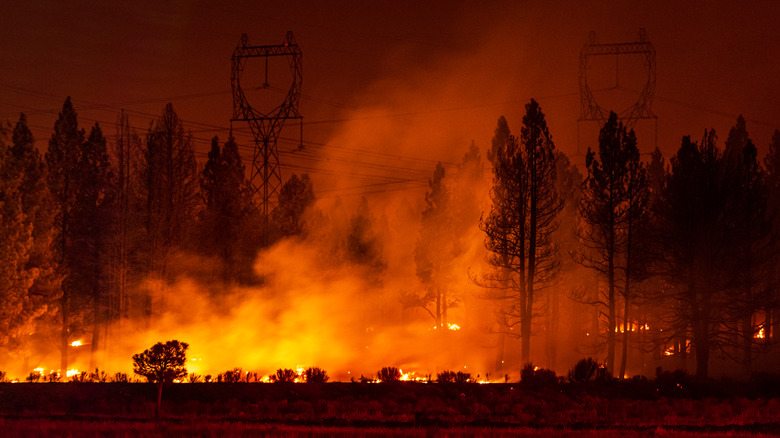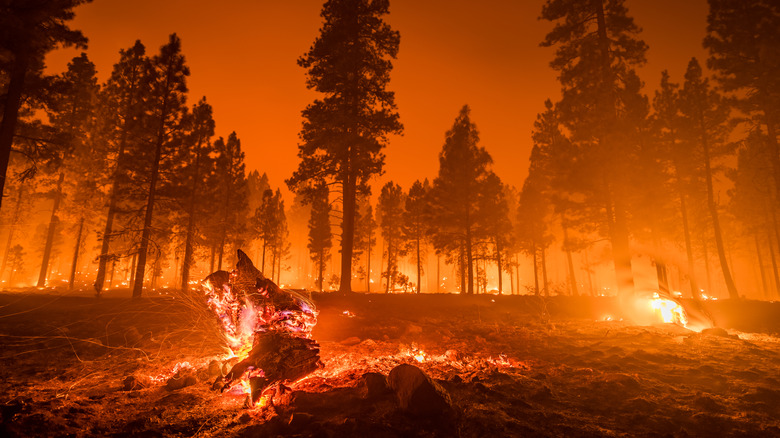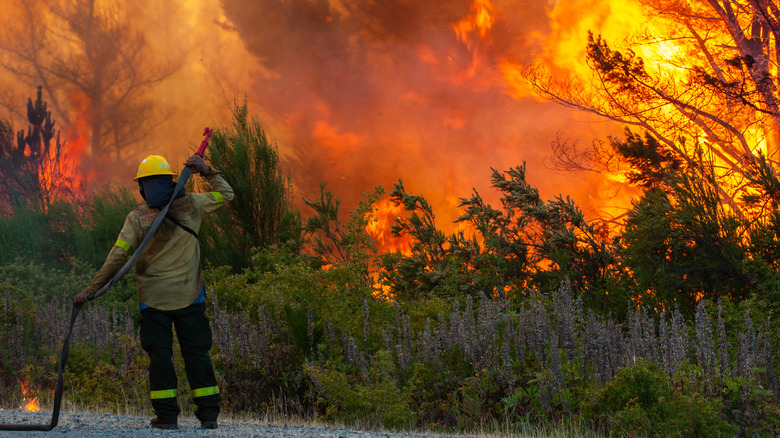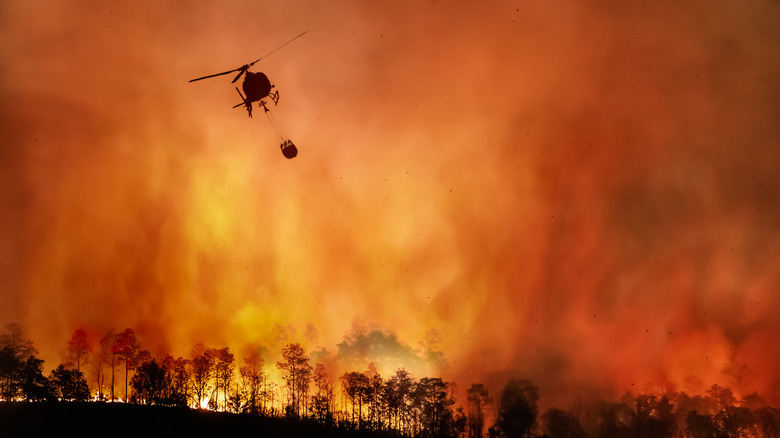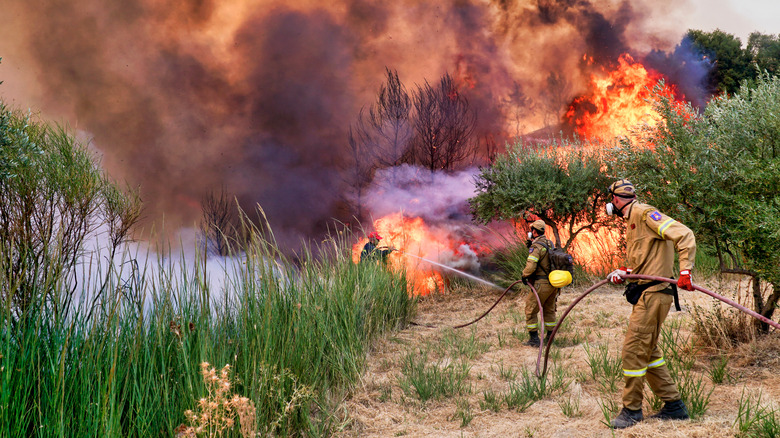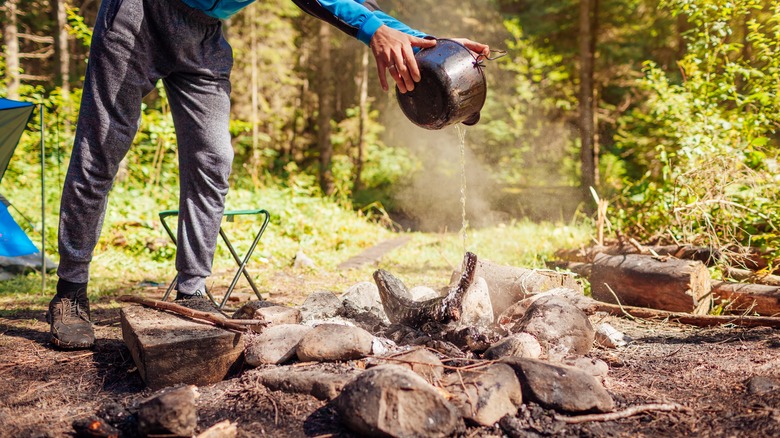How Do Wildfires Start?
Wildfires have become an increasingly concerning problem in recent years across the world, as many countries report the highest temperatures in decades (via BBC News). This year, wildfires are raging across several U.S. states and European countries. As these fires continue to grow out of control, it's important that we know how they start in the first place to prevent more from occurring.
As with any other fire, in order for a wildfire to begin it needs only three things: fuel, heat, and oxygen. This set of conditions is referred to as the "fire triangle" (via the NC State University's College of Natural Resources). With how dry some locations can get during the summer, many trees, shrubs, grasses, dead leaves, and more become highly flammable and thus make great fuel for a fire to begin. Combine that with the oxygen from the air and the summer heat, and all it takes is something small to trigger a fire.
Wildfires can be natural or caused by humans
Wildfires can be triggered by both natural causes and humans. According to the Bureau of Indian Affairs, the most common natural cause of wildfires is lightning, but volcanoes and meteors can occasionally cause them as well. While these fires can be seen as an inevitable part of nature, most wildfires are not caused by nature itself; the National Park Service reports that almost 85% of wildfires are caused by human activities.
There are many human activities that can potentially cause a wildfire. Idaho Firewise states that one out of five wildfires are caused by the burning of trash and debris. Another major contributor to wildfires is campfires that have been left unattended or have been improperly set up. Other activities that can trigger wildfires include smoking, equipment use, and arson. Even seemingly harmless and enjoyable activities like shooting fireworks can ignite a wildfire if done in the right conditions for a fire to start (via the Utah Department of Public Safety).
Wildfires can spread rapidly
The destructiveness of wildfires is a major concern, as is the speed with which they can spread. According to the NC State University's College of Natural Resources, an out-of-control wildfire can quickly decimate thousands of acres of land in just minutes. Just as there is a fire triangle to describe how fires start, there is a "fire behavior triangle" that determines how quickly they spread. The factors that make up the fire behavior triangle include fuel, weather, and topography (via the National Park Service).
When it comes to fuel, the more of it, the more quickly a fire can grow. In forests filled with trees and other plants, wildfires can expand extremely rapidly. Weather conditions, such as droughts, can help speed up this process, making plants in the area dry and highly flammable. Lastly, topography can have an effect on how fast wildfires spread. According to Rob Gazzard, technical advisor to the Forestry Commission in the U.K., if "a slope is going upwards at a 10% gradient, that would double the speed of the fire ... because it's pre-heating the fuel above it. So if a fire is going up a mountain, it will go very fast" (via BBC News).
The United Nations has declared a global wildfire crisis
As the number of wildfires continues to increase each year, world governments and environment protection agencies are desperate for a solution. In February, the United Nations Environment Program published a report stating that climate change is contributing to a "global wildfire crisis" that will continue to get worse over the next several decades.
In the United Nations report, a team of over 50 researchers concluded that the worldwide risk of devastating wildfires could increase as much as 57% before the end of the century. The report states that climate change is likely the primary cause of this, stating, "the heating of the planet is turning landscapes into tinderboxes" (via The New York Times). This is because climate change has contributed to hotter, drier climates in many parts of the world, including severe droughts in some places (via PBS). These dry, hot conditions are perfect for creating fires, making it easy for a blaze to start.
The UN Environment Program has a Fire Ready Formula
In response to the findings of the February 2022 report, the United Nations Environment Program (UNEP) created a new "Fire Ready Formula" that nations can use as a reference for allocating resources toward preventing and controlling wildfires. This formula aims to decrease the number and severity of fires by making sure no resources are wasted during a wildfire emergency.
The Fire Ready Formula states that 66% of funding for wildfire control should be used toward planning, prevention, preparedness, and recovery, while the remaining 34% should be spent on response (via Down to Earth). By putting most of the resources toward preventing and being prepared for fires, fewer resources will have to be spent putting them out. The UNEP report outlines specific actions that it recommends be taken in areas at risk for wildfires, including creating personal evacuation plans, regulating fire use, training, and the creation of hazard reduction strategies.
You can prevent wildfires by following fire safety tips
In addition to the work of environment protection agencies, there are things individuals can do to reduce the number of wildfires. If you're planning on lighting a fire while camping, the U.S. Department of the Interior recommends avoiding doing so in drought conditions, building your campfire in an open area, and dousing your fire with water until it is cold when you are finished.
Smokey the Bear wasn't lying when he said "only you can prevent wildfires." Although estimates vary slightly, experts agree that 85-90% of wildfires are caused by human activity (via the National Interagency Fire Center). With climate change causing an increase in drought conditions, many counties across the U.S. have put restrictions on fires and debris burning, with some outright banning them during certain times of the year. Before doing any activity involving creating a fire, check your local laws to make sure you don't contribute to the next major wildfire.
